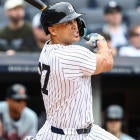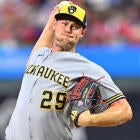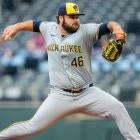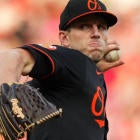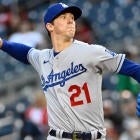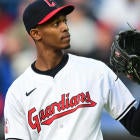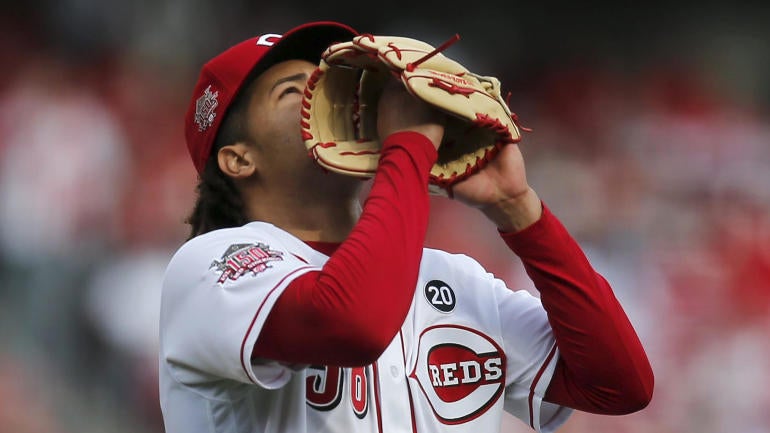
Too often, hundreds or even thousands of words are needed to build up to that carefully curated number that's going to blow the lid off your perception about a player when preparing for a Fantasy baseball draft. It's a lot of effort -- on both the writing and reading end -- for what could be an easy payoff.
So why not put all those impressive numbers in one place and let them more or less speak for themselves?
These are the ones that have jumped out to me in my preparations for 2021. Don't be surprised if more are added as a stumble upon them:
- Not only did Adalberto Mondesi's 24 stolen bases lead the majors but just one other player, Jonathan Villar, got even two-thirds of the way the way to his total, finishing with 16. Only six others got halfway there.
- Mondesi swiped 16 of those bases in his final 22 games, during which he hit .376 with six homers and a 1.130 OPS. He hit .179 with no homers and a .440 OPS in the 37 games that preceded it.
- AL Rookie of the Year Kyle Lewis can thank the month of August and that one week of July for his win. He hit .147 in September, when his strikeout rate jumped from 24.8 to 37.1 percent. It was 38.7 percent during his late-season debut two year ago.
- Of course, you could argue the September performance did more to help Lewis' Rookie of the Year candidacy than hurt it. He actually made up ground on chief competitor and eventual runner-up Luis Robert, who hit .136 with a .409 OPS in that final month. Robert entered September batting .298 with a .960 OPS.
- Albeit to a lesser degree, September was similarly unkind to consensus 2021 first-rounder Fernando Tatis, who was batting .313 with a 1.055 OPS going into the month but then batted .208 with a .714 OPS during it.
- Whatever the reason for Christian Yelich's struggles in 2020, it wasn't the way he impacted the ball. His average exit velocity and hard-hit rate were both his highest on record.
- Provided he were to sustain it over a full-length season, Lucas Giolito's 17.3 percent swinging-strike rate would have topped Gerrit Cole's record of 16.8 percent from 2019. But Giolito actually didn't have the highest swinging-strike rate among qualifiers in 2020. Jacob deGrom did ... at 21.6 percent.
- As good as Corey Seager was during a breakout 2020 campaign, batting .307 and slugging .585, Statcast's expected stats thought he deserved even better, pegging him for a .330 batting average and .653 slugging percentage. Mike Trout, just for comparison, has never had an xBA that high and has only once had an xSLG that high.
- Seager wasn't Statcast's biggest underachiever, though. Jake Cronenworth, who hit .285 and slugged .477, ranks just behind him on the expected stats leaderboard with .324 xBA and .541 xSLG, numbers that would have compared favorably to Tim Anderson.
- But Cronenworth wasn't Statcast's biggest underachiever either. The player with the single biggest discrepancy between his actual slugging percentage and his expected one was Bryce Harper, whose .307 xBA and .657 xSLG were the highest of his career, better than even during his MVP-winning 2015 season.
- Though Lance Lynn led the league in total innings, Yu Darvish, Kyle Hendricks and Framber Valdez all had more starts of seven innings or more (six).
- Zach Plesac was among the many who tied Lynn with five starts of seven innings or more, but he did it in only eight starts while most of the others had at least 12.
- Related: The top two pitchers in Head-to-Head points per game were, unsurprisingly, the Cy Young winners, Shane Bieber and Trevor Bauer. But Plesac was third at 21.44.
- More on Framber Valdez: Not only was his 60 percent ground-ball rate enough to lead the league but it also gave him a distinction shared only by 2015 Tyson Ross and 2017 Lance McCullers. They're the only 60-percent-ground-ball guys on record to have at least a strikeout per inning.
- More on Lance Lynn: While his 2020 seemed like a continuation of his breakthrough 2019, his xFIP jumped by nearly half a run, from 3.85 to 4.34. He ranked only 31st in that category among the 40 qualifying pitchers, just ahead of Kyle Gibson.
- Lynn was hardly the pitcher who most outperformed his xFIP, though. Two spots behind him on the xFIP leaderboard was Chris Bassitt, whose 4.49 mark betrayed a 2.29 ERA.
- Joe Musgrove recorded double-digit strikeouts in back-to-back starts to end 2020. They were his first double-digit strikeout efforts in 108 career appearances.
- The four home runs Jeff McNeil hit in 2020 came on four consecutive days in September.
- Perhaps as consequential as the change in Trevor Bauer's ERA (from 4.48 to 1.73) was the change in the spin rate on his fastball, which picked up more than 300 RPM to become the spinniest in all the land. HIs previous spin rate would have put him outside the top 75, behind pitchers like Carlos Carrasco and Dylan Bundy who make bank mostly on their offspeed pitches.
- Hyun-Jin Ryu's ERA over the past three seasons is 2.30. Only Jacob deGrom's 2.10 mark is lower.
- Three pitchers placed in the top five in both xFIP and xERA, Statcast's ERA estimator based on batted-ball probabilities. Two were exactly who you'd expect, Shane Bieber and Jacob deGrom, but if you're presuming Trevor Bauer was the third, you'd be wrong. Try Kenta Maeda.
- Maeda had the added distinction of being top five in swinging-strike rate, just behind deGrom and Lucas Giolito and just ahead of Bieber and Luis Castillo.
- Speaking of Castillo, who was the only pitcher last year to place in the top five in both swinging-strike rate and ground-ball rate. The same was true for him in 2019.
- We're not done with Castillo: He's also the career leader is swinging-strike rate, at least among starting pitchers.
- Between the regular season and playoffs, Blake Snell made 17 starts. Not a one of them lasted even six innings, the minimum required for a quality start.
- Meanwhile, only one of Walker Buehler's eight regular season starts went six innings, and in case you're thinking it's a Dodgers thing, that's compared to three for Dustin May, four for Tony Gonsolin and five for Julio Urias. The Dodgers did unleash for Buehler for two six-inning starts in the playoffs.
- Speaking of Urias, his K/9 rate jumped from 7.4 in 55 regular season innings to 11.3 in 23 postseason innings, which accompanied a 1 mph increase in average fastball velocity. Of course, he was deployed out of the bullpen for much of the postseason, but every one of his outings surpassed two innings.
- Randy Arozarena hitting .281 with seven homers in 65 regular season at-bats is eye-catching enough, but factor in the postseason and his stat line jumps to .333 with 17 homers in 141 at-bats. That's as many home runs as Mike Trout hit, but in 58 fewer at-bats.
- Jose Altuve doubled his 2020 home run count by hitting five in the postseason. The work he did in those 48 at-bats would have raised his batting average from .219 to .250 if applied to his regular season stat line.
- More fun with postseason stats: Carlos Correa hit more home runs (6) in 47 postseason at-bats than he did (5) in 201 regular season at-bats.
- Braves rookie Ian Anderson made 10 starts between the regular season and playoffs. He allowed two hits or fewer in five of them.
- Dane Dunning's 17.9 percent swinging-strike rate through his first three starts would have ranked second among all qualifiers. His 6.9 percent rate through his final four starts would have ranked dead last.
- Meanwhile, John Means' swinging-strike rate jumped from 8.7 percent in his first six starts to 15.7 in his final four, and with it, his K/9 jumped from 5.4 to 11.4 and his ERA fell from 8.10 to 1.52.
- Want another? Griffin Canning's swinging-strike rate jumped from 9.9 percent in his first six starts to 14.5 in his final five, and with it, his K/9 jumped from 7.5 to 10.4. His ERA dropped from 4.88 to 3.14.
- Shane Bieber's 14.2 K/9 may have led all qualifiers, but Drew Smyly's 14.4 K/9 led all pitchers with at least five starts.
- Spin rate generally doesn't get much attention for changeups, but Devin Williams' led the category by more than 400 RPM. The gap between him and No. 2 was bigger than between No. 2 and No. 69. It was a pitch he threw more than half the time and was largely responsible for his 17.7 K/9 that tied James Karinchak for most among pitchers with at least 25 innings.
- More on Williams: In all, he made 22 appearances. He struck out three or more in nine of them. He allowed a hit in only seven.
- Unsurprisingly, DJ LeMahieu had the most Head-to-Head points per game among second base-eligible players last year. Second-most? Dylan Moore.
- You may remember Jared Walsh grabbing headlines for his seven home runs in a span of 10 games last September, but more significant was his sudden development of contact skills -- or at least the appearance thereof. His 13.9 percent strikeout rate was like something you'd see from Jeff McNeil.
- Despite his inconsistent playing time, Dodgers catcher Will Smith lowered his strikeout rate from 26.5 percent in 2019 to 16.1 percent in 2020. That's like the difference between Pete Alonso and Whit Merrifield.
- Less dramatic but even more under the radar was Austin Riley's drop in strikeout rate from 36.4 to 23.8 percent, taking him out of the Joey Gallo range and moving him into the Tim Anderson range.
- After hitting three home runs with a .647 OPS in his first 25 games, Joey Votto hit eight home runs with a .941 OPS in his final 29.
- Conversely, after hitting 10 home runs with a 1.167 OPS in his first 33 games, Votto's teammate Jesse Winker hit two home runs with a .546 OPS in his final 21.
- Think you got Cristian Javier pinned down? You'd be one step ahead of two of the most popular ERA estimators. The gap between his xERA (2.94) and his xFIP (4.86) is the largest among pitchers with at least 50 innings.
- The aforementioned Julio Urias is near the top of that list as well with a 3.41 xERA compared to a 5.06 xFIP.
- More fun with xERA and xFIP: Chris Paddack had a 5.08 xERA compared to a 3.77 xFIP in 2020. He had a 3.39 xERA compared to a 4.05 xFIP in 2019.
- Giancarlo Stanton hit five balls with an exit velocity of 115 mph or greater, most in the majors. He did this despite playing in only 23 games.
- Who was second on the list of balls batted at least 115 mph? Vladimir Guerrero. He's still second if you broaden the selection to 110 mph, and he's third if you broaden it to 105. He may not know how to elevate for power yet, but he certainly hits the ball hard enough.
- Speaking of hard-hit balls, Fernando Tatis set a new standard for hard-hit rate, defined as balls batted at least 95 mph, at a whopping 62.2 percent. To put it in perspective, the previous high recorded by Statcast was Aaron Judge's 55.3 percent in the year he hit 52 home runs.
- For the fifth straight year, Nick Castellanos ranked in the top 10 percent in expected slugging percentage, but in only one of those years (2019) has he come within even 30 points of his xSLG.
- Tyler Mahle's ERA dropped to 3.59 and his K/9 rose to 11.3 with his development of a new slider last year, but its effect might be most evident in how he fared the third time through the lineup. In 2019, batters went 34 for 97 (.351) with a 1.004 OPS against him the third time through. Last year, they went 2 for 31.
- Six of Adam Duvall's 16 home runs came in two games. Take them out and he ends the year batting .214 with a .699 OPS.
- Salvador Perez batted nearly 100 points higher and slugged nearly 200 points higher than in his last full-length season (2018).
- Dinelson Lamet delivered more double-digit strikeout efforts (four) than both Yu Darvish (three) and Lucas Giolito (three).
- Playing for the team that faced unparalleled COVID-19 interference, Jack Flaherty never did quite find his groove, his ERA swelling to 4.91. But his xFIP (3.42) actually improved from 2019 (3.64), offering reassurances about his skills.
- Craig Kimbrel may have finished the year with a 5.28 ERA and 1.44 WHIP, but he allowed just three baserunners in his final eight appearances, striking out 13 of the 24 batters he faced.
- Brandon Belt hit .383 with seven home runs and a 1.246 OPS on the ro -- no, not this time. He did it at home.














